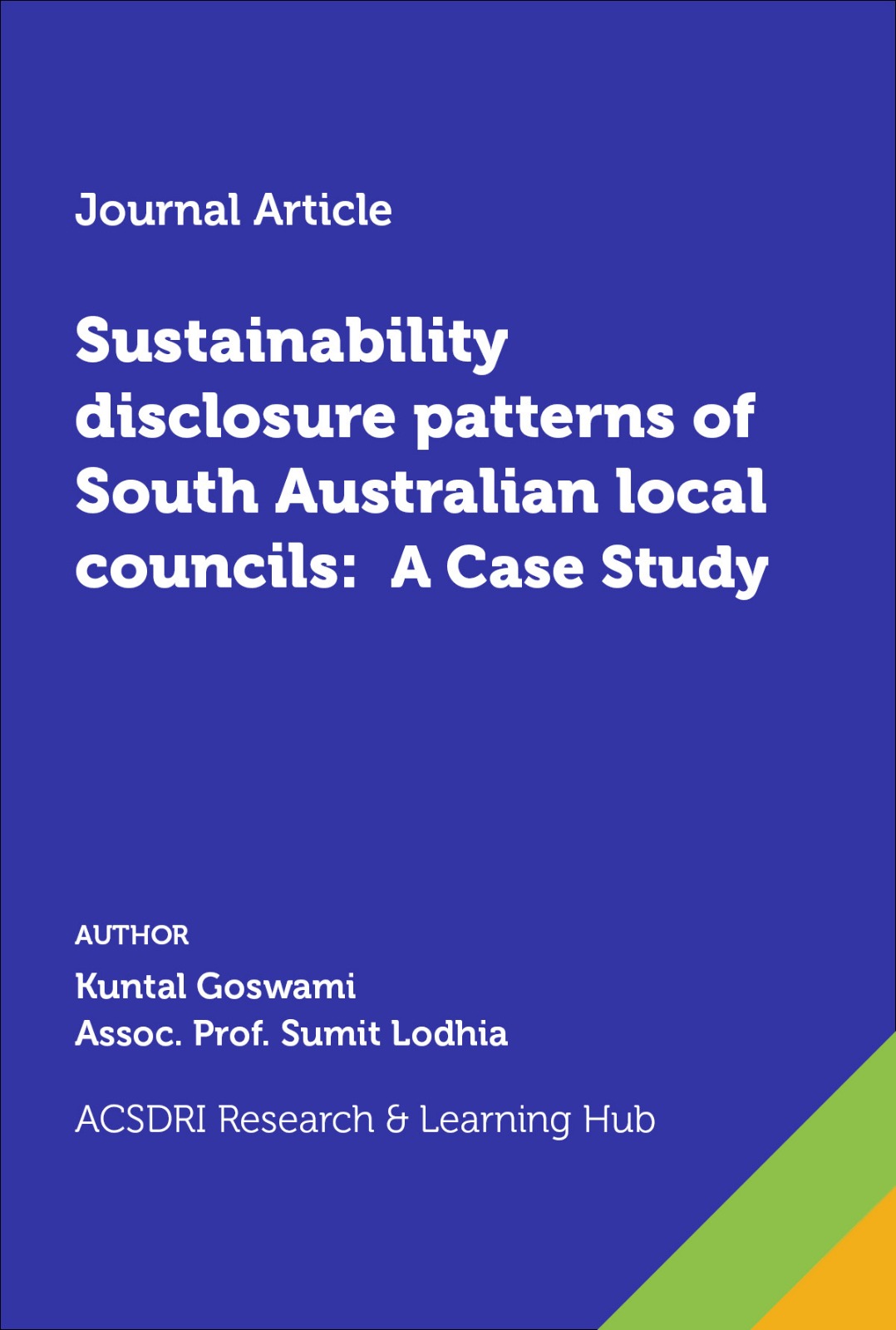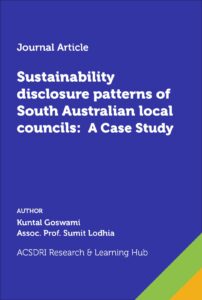Journal Articles
Sustainability disclosure patterns of South Australian local councils: A case study
Sustainability Reporting patterns of South Australian local councils: a case study
Authors: Kuntal Goswami and Sumit Lodhia
This article investigates the types of sustainability information disclosed by four South Australian local councils without any mandatory sustainability reporting guidelines. The findings suggest that even though standardized sustainability reporting guidelines are not in use, elements of these guidelines are reported as sustainability issues in annual reports. Our study also reveals that multiple overlapping guidelines based on contemporary sustainability philosophies are used in the absence of prescribed requirements. A need for local-centric guidelines is suggested, not just for the context of this study but also for other local governments, nationally and internationally.
Keywords: Sustainability Reporting, Content analysis, Global Reporting Initiative (GRI), Sector Supplement for Public Agencies (SSPA), South Australian local government,
Citation: Goswami, K and Lodhia, S (2014) Sustainability Disclosure Patterns of South Australian Local Councils: A Case Study, Public Money and Management, Vol. 34, No.4, pp. 273-280 https://doi.org/10.1080/09540962.2014.920200 (ABDC 2013 Rank: A, Impact Factor = 0.781). https://acsdri.com/publications-on-sustainable-development/sustainability-reporting-patterns-of-south-australian-local-councils/
Introduction to Sustainability Reporting
Conventional accounting reports are primarily concerned with disseminating information on accounting profits, cash flows, and shareholder wealth and present only some of the information required to make economic decisions in the context of sustainability (Lamberton, 2005; Alexander and Archer, 2009).
Sustainability reporting highlights an organization’s economic, social, and environmental performance. With 40% of all global economic activities in the public sector domain, this sector has a significant role in promoting sustainability compared to the private sector (Ball and Grubnic, 2007). The Global Reporting Initiative (GRI, 2005) has argued that sustainability reporting is essential for public agencies because they are significant employers, providers of services, and consumers of resources and, therefore, have a major impact on national and global progress toward sustainable development.
The GRI has called on public agencies to lead by example in reporting publicly and transparently on their activities to promote sustainability. Despite this, the academic literature suggests that sustainability reporting practices in the public sector need to be revised and at a nascent stage (Dickinson et al., 2005).
This study investigates sustainability reporting by local councils in South Australia. South Australia is particularly interested in this context because it is more susceptible to the adverse effects of climate change than other Australian states (Pillora, 2010). Economic growth and social issues, such as employment, are critical in South Australia, resulting in an increasing need to embrace sustainability values and principles.
Our research provides lessons for local governments worldwide by suggesting that the lack of use of the GRI does not necessarily imply a lack of disclosure of social, environmental, and economic issues. Our paper also highlights the importance of local initiatives and guidelines to enhance sustainability performance and suggests the need for a holistic and contextual reporting framework.
Sustainability Reporting Patterns: Local government perspectives
There have been several attempts to develop a local government-specific sustainability reporting approach (Net Balance, 2011). These frameworks aim to develop community-level indicators within the scope of the activities of local councils through community consultation processes (Wiseman et al., 2006).
The frameworks also attempt to present meaningful and relevant indicators to local communities by integrating local social (well-being and quality of life), economic, environmental, and governance issues—the so-called ‘quadruple bottom line.’ (QBL) reporting approach (Olesson et al., 2012). The QBL is an extension of the earlier triple-bottom-line reporting approach with an additional focus on governance.
In presenting holistic sustainability reporting in the public sector, the GRI’s Sector Supplement for Public Agencies (SSPA) is one of the most accepted frameworks (Williams, 2011). The GRI released the SSPA guidelines in 2005 to guide the public sector on what to report as sustainability issues (Tort, 2010). SSPA performance indicators include three dimensions of sustainability—economic, environmental, and social—and under each dimension, a performance indicator can be ‘core’ or ‘additional’ (GRI, 2005).
The GRI’s SSPA framework is designed to address the reporting expectations of diverse stakeholders in the public sector. In addition to the sustainability indicators, the SSPA framework has six other indicators relating to ‘public policies and implementation measures’. These indicators explain the agency’s policy priorities and implementation measures related to sustainable development (GRI, 2005).
Studies focusing on the application of the GRI guidelines in local government have revealed that these reporting guidelines are in limited use due to a lack of trained staff, a lack of resources, and, most importantly, a lack of knowledge about the GRI guidelines (Sciulli, 2011; Williams, 2011). Furthermore, a study by Guthrie and Farneti (2008) on sustainability reporting practices of the Australian public sector revealed that in the absence of mandatory requirements to report sustainability issues, disclosures are ‘fragmentary’ or ‘cherry-picked’ and organizations usually only disclosed those GRI indicators in their annual reports that they were interested in reporting.
In this regard, Ball and Bebbington (2008) argued that although the public sector is reporting sustainability issues in some instances, there is a need for a common sustainability reporting guideline for comparability. Farneti and Siboni (2011) illustrated the effect of local government guidelines on reporting practices in Italian local government and found only limited attention given to sustainability issues. For guidelines to be developed in Australian local government, further political support from both the federal and the state levels of government is needed, without which the change process will be slow and evolutionary (Herbohn and Griffiths, 2008).
Local government in South Australia
South Australia has 68 local councils, which collectively these councils act as an industry. Local councils are one of the significant sources of employment and investment in the state and a primary provider of public goods and services. Recent estimates reveal that local governments in South Australia manage about $10 billion of infrastructure, provide over $1 billion of services yearly, generate more than 8,000 local jobs, and play a significant role in local planning and economic development (LGA, 2012).
The state government has tried to follow the Kyoto Protocol in several ways, for example, the South Australian Greenhouse Strategy 2007–2020, setting up the Premier’s Climate Change Council, and their plan to reduce South Australia’s emissions to 1990 levels during 2008–2012 (Pillora, 2010). In South Australia, all councils are governed by the Local Government Act 1999. Under this Act, each council must manage its business sustainably and conserve the local environment.
Councils are required to facilitate sustainable development and to ensure a proper balance within their communities between economic, social, environmental, and cultural considerations (Government of South Australia, 1999). However, there is still no mandatory requirement to publish sustainability reports. There is scope for further research specific to South Australian local councils. In this context, this research is undertaken to understand the types of information reported as sustainability issues without any mandatory reporting guidelines. READ MORE




